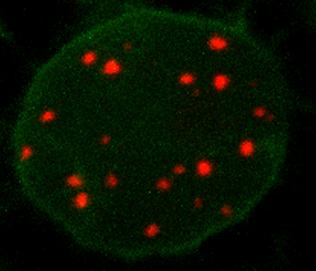Novel application of CRISPR/Cas9 in plants – Visualizing DNA in living cells

Living nucleus of the plant Nicotiana benthamiana shows red fluorescent labelled telomere sequences IPK/Steven Dreissig
The spatial and temporal organization of genomes is important for maintaining and regulating cell functions such as gene expression, DNA replication and repair, and proper segregation of genetic material during cell division. Therefore, elucidating how the genome is spatio-temporally organized inside the nucleus is imperative to understand how genes and non-coding DNA sequences are regulated during development.
Mapping the functional organization of the genome can be achieved by visualizing interactions between different genomic elements in living cells. “While fluorescence-tagged nuclear proteins can be readily imaged in living plant cells, in vivo visualization of defined DNA sequences turned out to be technically difficult”, explains Andreas Houben, head of the research group Chromosome Structure and Function of the IPK.
The discovery of the bacterial originated CRISPR-Cas9 system (type II clustered regularly interspaced short palindromic repeats CRISPR-associated caspase) revolutionized the field of the targeted genome editing in the last five years and has become a routine technology. “By harnessing this system for live cell imaging in plants, our team shows the potential of this technology reaches far beyond the controlled induction of mutations”, explains Steven Dreissig, IPK scientist and first author of the study.
“We demonstrate reliable imaging of telomere repeats located at the ends of the chromosome arms in living cells of Nicotiana benthamiana, a close Australian relative of tobacco, and pave the way for potential visualization of multiple genomic loci.”
“Furthermore, we show that CRISPR-Cas9 can be combined with fluorescence-labelled proteins to investigate DNA-protein interactions in living cells”, adds Holger Puchta, Director of the Botanical Institute in Karlsruhe.
This recent development may potentially enable plant scientists to visualize single genomic loci in living cells. Now the researchers report the outcome of their joint work in The Plant Journal.
Publication: Steven Dreissig, Simon Schiml, Patrick Schindele, Oda Weiss, Twan Rutten, Veit Schubert, Evgeny Gladilin, Michael Florian Mette, Holger Puchta & Andreas Houben (2017): Live cell CRISPR-imaging in plants reveals dynamic telomere movement. The Plant Journal
DOI: dx.doi.org/10.1111/tpj.13601
Media Contact
More Information:
http://www.ipk-gatersleben.deAll latest news from the category: Life Sciences and Chemistry
Articles and reports from the Life Sciences and chemistry area deal with applied and basic research into modern biology, chemistry and human medicine.
Valuable information can be found on a range of life sciences fields including bacteriology, biochemistry, bionics, bioinformatics, biophysics, biotechnology, genetics, geobotany, human biology, marine biology, microbiology, molecular biology, cellular biology, zoology, bioinorganic chemistry, microchemistry and environmental chemistry.
Newest articles

A universal framework for spatial biology
SpatialData is a freely accessible tool to unify and integrate data from different omics technologies accounting for spatial information, which can provide holistic insights into health and disease. Biological processes…

How complex biological processes arise
A $20 million grant from the U.S. National Science Foundation (NSF) will support the establishment and operation of the National Synthesis Center for Emergence in the Molecular and Cellular Sciences (NCEMS) at…

Airborne single-photon lidar system achieves high-resolution 3D imaging
Compact, low-power system opens doors for photon-efficient drone and satellite-based environmental monitoring and mapping. Researchers have developed a compact and lightweight single-photon airborne lidar system that can acquire high-resolution 3D…





















